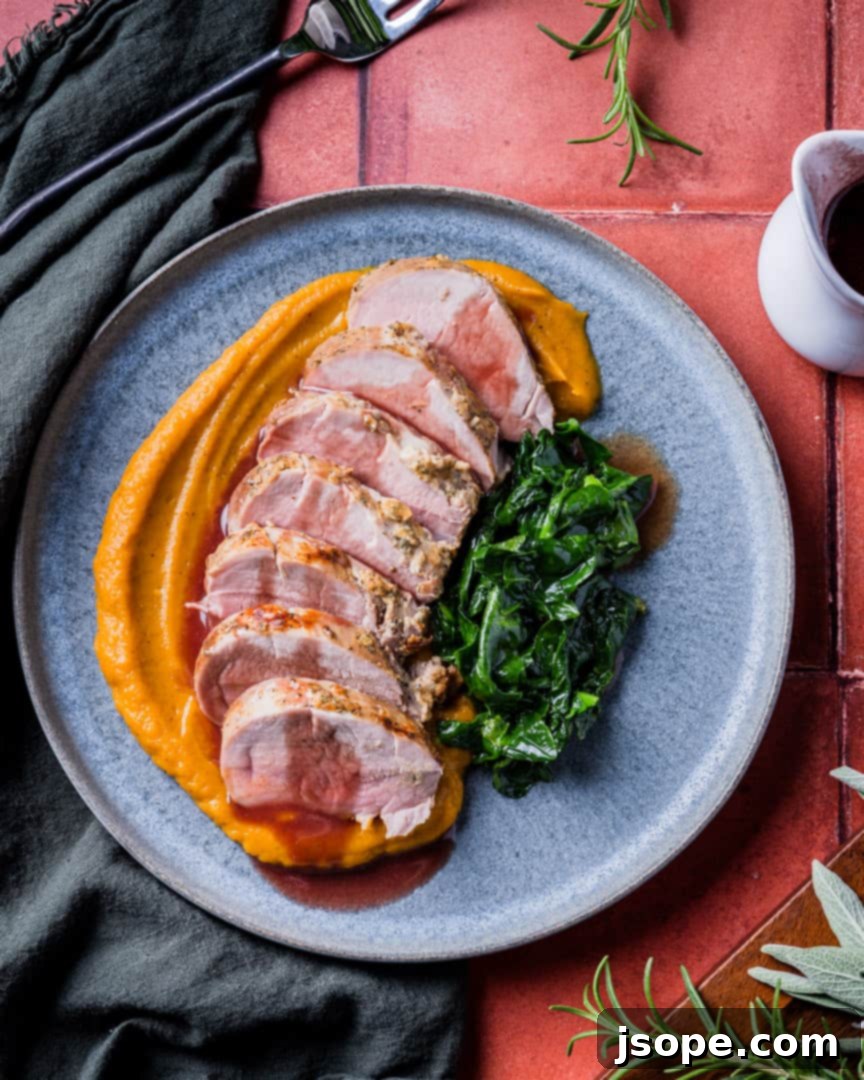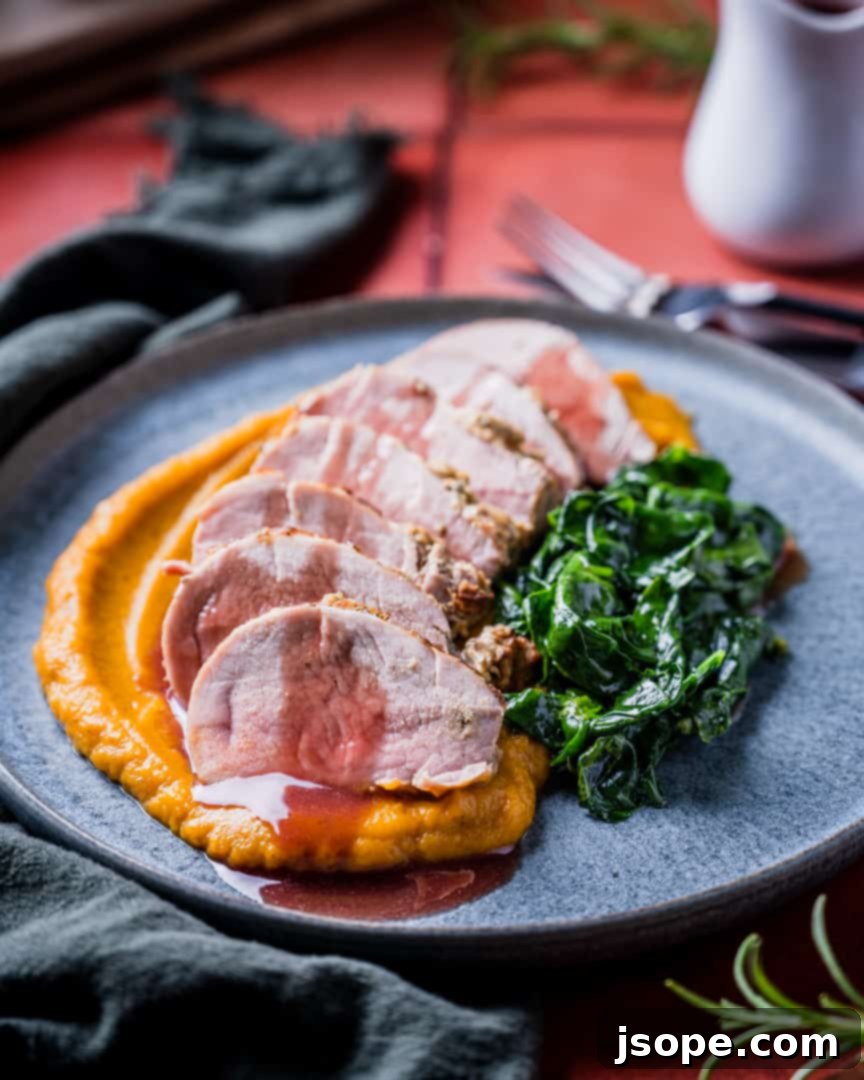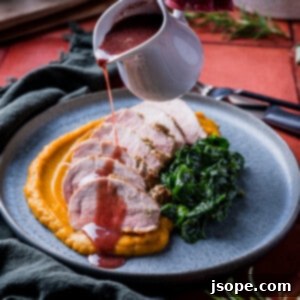As the crisp air of autumn sweeps in, bringing with it the excitement of football season, cozy sweaters, and cherished family gatherings, our palates naturally crave dishes that offer warmth, comfort, and rich flavor. After enduring the sweltering heat of summer, the arrival of fall is a welcome relief, and what better way to celebrate the change of seasons than with a truly exceptional meal?
This recipe for **Herb Crusted Pork Tenderloin with Juniper Red Wine Sauce** is designed to transform an often-overlooked cut of meat into a centerpiece-worthy dish. Pork tenderloin, while lean and relatively inexpensive, can sometimes be bland or dry if not prepared correctly—much like a boneless, skinless chicken breast. However, with a few simple yet effective techniques, we can unlock its full potential, ensuring every bite is moist, tender, and bursting with flavor. Forget those dry, uninspiring “other white meat” experiences; this dish promises to elevate your culinary repertoire and delight your guests, whether for a festive holiday meal, a special Sunday dinner, or even an impressive weeknight treat.

Unlock Flavor and Juiciness: The Art of Dry Brining Pork Tenderloin
One of the foundational steps to achieving a succulent and flavorful pork tenderloin in this recipe is the dry brine, followed by a savory mustard rub. We understand that this involves a little advanced planning, but we promise the minimal effort invested upfront will yield profoundly superior results. Dry brining is a game-changer for lean cuts of meat like pork tenderloin, ensuring they remain wonderfully juicy and tender throughout the cooking process.
So, what exactly happens during a dry brine? When you season pork generously with salt and pepper and allow it to rest uncovered in the refrigerator, a fascinating scientific process begins. Initially, the salt on the surface of the meat draws out some of its natural moisture through osmosis. This moisture then dissolves the salt, creating a highly concentrated brine on the surface. Over time, this saline solution is reabsorbed back into the meat, carrying the salt deep into the muscle fibers. This process not only seasons the pork from within but also alters the protein structure, allowing the muscle cells to retain moisture much more effectively during roasting. The result? A pork tenderloin that is consistently juicy, incredibly tender, and seasoned perfectly from edge to center, preventing the dreaded dryness that can often plague lean meats.
Our method involves two distinct resting periods. The first is with just salt and pepper, which initiates the brining effect. Keeping the pork uncovered helps to slightly dry the surface, which is crucial for developing a beautiful, crisp crust during roasting. The second resting period incorporates the Dijon mustard and fresh herbs. Applying the mustard and herb mixture after the initial brine allows it to adhere more effectively as the surface of the pork is already somewhat dry. As the pork rests further with the rub, the mustard also dries out slightly, creating an even stronger bond with the meat. This ensures that the herb crust forms a delicious, aromatic layer that won’t fall off during cooking, intensifying both the flavor and texture of the dish.
Don’t be intimidated by the mustard! While it forms a critical part of the rub, its flavor mellows considerably during roasting. It acts more as a binder for the herbs and a catalyst for a delicious crust rather than an assertive, dominant flavor. It adds a subtle tang and complexity that complements the pork and herbs beautifully, without making the dish taste “mustard-forward.”
While the science is compelling, the proof is truly in the eating. This technique, though requiring a bit of patience, guarantees a pork loin that is far more tender, juicy, and flavorful than one cooked without this essential step. Even if your schedule only allows for a shorter brining period, you will still notice a significant improvement in the final dish. It’s a simple investment of time for an extraordinary culinary reward.

Is Dry Brining Optional? The Impact of Skipping This Step
Technically, you *can* prepare this recipe without dry brining the pork tenderloin. However, we strongly advise against it if you’re aiming for the best possible outcome. Skipping the dry brine means sacrificing a significant amount of tenderness, juiciness, and flavor that this method imbues into the meat. The pork will be more prone to drying out during roasting, a common pitfall when cooking lean cuts. Furthermore, the herb and mustard rub may not adhere as effectively to an unbrined surface, potentially leading to a less pronounced and less flavorful crust. The dry brine process is specifically designed to lock in moisture and create an ideal surface for the herb rub, ensuring a truly exceptional Herb Crusted Pork Tenderloin. For a dish that is consistently succulent, perfectly seasoned, and boasts a magnificent crust, we wholeheartedly recommend following the dry brining instructions as detailed in the recipe.
The Perfect Companion: Crafting the Juniper Red Wine Sauce
No elegant roast is complete without a complementary sauce, and our **Juniper Red Wine Sauce** is truly the crowning glory of this Herb Crusted Pork Tenderloin. This exquisite sauce is more than just an accompaniment; it’s a harmonious blend of flavors designed to enhance and elevate every bite. It beautifully balances the savory herbs in the pork crust, adding a layer of sophisticated depth.
The star ingredient here, besides the rich red wine, is juniper. Juniper berries, with their distinctive piney, slightly citrusy, and subtly peppery notes, are a classic and natural flavor pairing for pork. Their unique aroma provides a wonderful counterpoint to the earthiness of rosemary and sage, creating a complex and intriguing flavor profile that is both rustic and refined. We gently crack the juniper berries, rather than crushing them completely, to allow their essential oils to infuse the sauce gradually, preventing any bitterness and ensuring a smooth, aromatic finish.
This sauce is primarily a masterful wine reduction. We combine a robust dry red wine with tawny port, which adds a luscious sweetness and depth, creating a rich foundation. The shallots provide a delicate oniony base, while black peppercorns add a mild spice. The reduction process concentrates these flavors into a remarkably complex and intensely aromatic liquid. The grand finale involves finishing the sauce with cold, unsalted butter. This technique, known as “monter au beurre” in French cuisine, is essential for adding incredible richness, a luxurious sheen, and a silky-smooth texture without making the sauce overly thick. The butter emulsifies into the warm reduction, creating a velvety consistency that coats the pork beautifully and tantalizes the taste buds. The slight acidity from the wine is perfectly balanced by the richness of the butter and the nuanced sweetness of the port, resulting in a sauce that is both bold and beautifully balanced.
Elevate Your Meal: Inspired Side Dishes for Herb Roasted Pork Tenderloin
The versatility of Herb Crusted Pork Tenderloin means you have a wealth of options when it comes to selecting accompanying side dishes. This dish pairs beautifully with a variety of flavors and textures, making it easy to tailor your meal to any occasion or preference. Here are some of our top recommendations, designed to complement the rich, herb-infused flavors of the pork and the juniper red wine sauce:
Spicy Butternut Squash Puree: (Recipe coming soon!) Imagine a vibrant, creamy puree with a hint of spice, offering a delightful sweetness that perfectly contrasts the savory pork. The smooth texture provides a lovely counterpoint to the tenderloin’s crust, and its autumnal flavors truly echo the spirit of the season.
Sautéed Spinach: For a lighter, earthier option, simple sautéed spinach with a touch of garlic is an excellent choice. Its slightly bitter notes and tender texture cut through the richness of the pork and sauce, offering a refreshing and healthy balance to the meal.
Parmesan Peppercorn Mashed Potatoes: Creamy, decadent mashed potatoes infused with sharp Parmesan cheese and a kick of black peppercorns are always a crowd-pleaser. They provide a comforting, substantial base that eagerly soaks up the exquisite juniper red wine sauce, making every forkful a luxurious experience.
Barley Pilaf: If you’re looking for a hearty, textural alternative to potatoes, a savory barley pilaf is an excellent choice. Its chewy grains and nutty flavor make it a robust accompaniment, perfect for absorbing the delicious sauce and adding a satisfying element to the plate.
Beyond these specific suggestions, consider other roasted root vegetables like carrots, parsnips, or sweet potatoes for an additional layer of natural sweetness and earthiness. A fresh green bean almondine or a simple mixed green salad with a vinaigrette could also provide a refreshing counterpoint. For wine pairings, a medium-bodied red like a Pinot Noir, Merlot, or a lighter Zinfandel would complement the savory pork and the berry notes in the sauce beautifully. A dry rosé could also be a delightful choice, especially if you prefer a lighter wine.
Explore More Culinary Delights: Our Favorite Pork Recipes
If you’ve enjoyed this delightful Herb Crusted Pork Tenderloin and are eager to explore more ways to prepare this versatile meat, we have a collection of other fantastic pork and pork loin recipes that we think you’ll love. Each offers a unique flavor profile and cooking experience, promising to add exciting new dishes to your repertoire:
Spinach and Sun-Dried Tomato Pesto Stuffed Pork Tenderloin: An impressive and flavorful dish where tender pork is stuffed with a vibrant, savory filling of spinach and sun-dried tomato pesto, creating an elegant presentation and an explosion of Mediterranean-inspired flavors.
Stewed Spiced Pork with Cinnamon Rice: A comforting and aromatic dish featuring tender pork slow-cooked with warming spices, served alongside fragrant cinnamon-infused rice for a hearty and satisfying meal with a hint of global flair.
Elevated Pork Chops and Fennel Applesauce: A refined take on a classic pairing, these expertly prepared pork chops are served with a sophisticated applesauce infused with the subtle sweetness of fennel, offering a balanced and deliciously innovative combination.
Savor the Experience and Share Your Creations!
We genuinely hope that you thoroughly enjoy crafting and savoring this incredible Herb Crusted Pork Tenderloin with Juniper Red Wine Sauce. It’s a recipe designed to bring joy and deliciousness to your table, making any meal feel like a special occasion. We believe its rich flavors, tender texture, and aromatic sauce will make it a new favorite in your household.
If you decide to give this recipe a try and find yourself loving it as much as we do, please don’t hesitate to share your experience! We would be thrilled if you could leave us a 5-star rating and a comment below to let us know how it turned out. Your feedback is invaluable and truly brightens our day. You can also tag us on Instagram @cooking_with_wine so we can see your beautiful culinary creations!

Eager for more inspiring and delicious recipes like this one? Dive into these other culinary explorations:
- Garlic Thyme Studded Beef Tenderloin Roast with Red Wine Sauce – A truly luxurious and impressive roast, perfect for special gatherings, featuring aromatic garlic and thyme with a rich red wine sauce.
- Sage Prosciutto and Gruyere Chicken Roulade – An elegant and flavorful chicken dish, where tender chicken breasts are rolled with savory prosciutto, fragrant sage, and melted Gruyere cheese.
- Pan Seared Duck with Cherry Port Sauce – A sophisticated and rich dish, offering perfectly seared duck breast complemented by a luscious sweet and tangy cherry port sauce.
- Peppercorn Crusted Steak with Brandy Cream Sauce – For steak lovers, this recipe delivers a bold, peppery crust paired with an indulgent, creamy brandy sauce that elevates a simple steak to gourmet status.
📖 Recipe

Herb Crusted Pork Tenderloin with Juniper Red Wine Sauce
Pin Recipe
Ingredients
For the Pork
- 2 lb pork tenderloin, trimmed (2 small pork tenderloins)
- 2 teaspoon kosher salt
- ½ teaspoon black pepper
- ¼ cup Dijon mustard
- 1 tablespoon + 1 teaspoon fresh sage, finely chopped
- 1 tablespoon + 1 teaspoon fresh rosemary, finely chopped
- ½ teaspoon dried ginger
For the Sauce
- 2 teaspoon olive oil
- 1 medium shallot – finely chopped
- 1 cup dry red wine
- ½ cup tawny port
- 6 black peppercorns
- 8 juniper berries
- 6 tablespoon cold unsalted butter – cubed
- Kosher salt to taste
Instructions
Dry Brine the Pork
- To dry brine the pork, first dry the trimmed pork tenderloin thoroughly. Sprinkle the meat on all sides with the salt and pepper and place pork on a wire rack over a roasting pan. Refrigerate uncovered for 3 hours.
- After 3 hours, mix the mustard, sage, rosemary, and dried ginger together in a small bowl. Remove the pork from the refrigerator and coat with the herb mixture. Return the pork to the rack and refrigerate for another hour (or up to several hours).
Roast the Pork
- Preheat the oven to 425°F.
- Remove the roasting pan with the pork from the refrigerator 30 minutes and let it sit at room temperature before putting it in the oven. Once the oven is up to temp, place the roasting pan in the hot oven and cook the pork loin until the internal temperature reaches 145°F on a meat thermometer. This will take about 25-35 minutes. The cooking time will depend on the thickness of the meat, so we highly recommend using an instant-read thermometer to make sure it is cooked properly. Let the pork rest for 7-10 minutes before slicing.
Prepare the Sauce
- While the pork is roasting, heat the olive oil in a saucepan over medium heat. Add the shallots and cook until they just start to brown.
- Gently crack the juniper berries by smashing them with the flat side of the blade of a kitchen knife. Don’t crush them completely, just crack them a bit so they can release their flavor. Add the wine, port, peppercorns, and juniper berries to the pan and bring to a simmer. Turn the heat down slightly and reduce the liquid by half.
- Once reduced, strain the mixture and discard the solids. Return the liquid to the saucepan and reduce until you have about 6 tablespoons of liquid remaining. Up to this point, you can make this part of the sauce in advance if desired, just reheat gently before moving to the next step.
- While the pork roast rests on a cutting board, remove the reduced sauce from the heat and whisk in the butter one cube at a time until fully incorporated. If the sauce is not warm enough to melt the butter you can return to a low heat, but do not use high heat or bring the sauce to a boil. This is more of a reduction sauce mounted with butter than a butter sauce, so it is less delicate and somewhat thinner than a butter sauce.
- Taste and adjust the amount of salt if needed and serve the sauce over your sliced pork tenderloin. Enjoy!
Nutrition
Do You Love Our Recipes? Support Our Culinary Journey!
We are dedicated to providing you with delicious and high-quality FREE recipes here on Cooking With Wine. Crafting these recipes, testing them, and sharing our passion for food takes time, effort, and resources. If you appreciate our content and would like to support our ongoing efforts to bring you more culinary inspiration, you can contribute any amount you feel comfortable with below. Your generosity helps us continue to create and share the dishes you love.
Buy us a coffee
Please know that there is absolutely no obligation to contribute! We will continue to provide you with wonderful recipes regardless. However, any and all contributions are deeply appreciated and go a long way in sustaining our work.
Thank you for being such a wonderful part of our community! Your enthusiasm and support are the very reasons we do what we do, and we cherish every single one of you.
